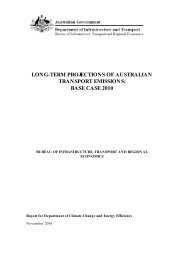Implications of Climate Change for Australia's World Heritage ...
Implications of Climate Change for Australia's World Heritage ...
Implications of Climate Change for Australia's World Heritage ...
You also want an ePaper? Increase the reach of your titles
YUMPU automatically turns print PDFs into web optimized ePapers that Google loves.
IMPLICATIONS OF CLIMATE CHANGE FOR AUSTRALIA’S WORLD HERITAGE PROPERTIES: A PRELIMINARY ASSESSMENT<br />
Rainfall and extreme weather events<br />
Higher temperatures and changes in humidity—as well as extreme weather events including wind, severe rain, lightning and<br />
hail—can have a direct impact on the fabric <strong>of</strong> buildings and culturally significant gardens. <strong>Change</strong>s in rainfall (prolonged<br />
drought or excessive rainfall) can also affect building fabric, vegetation and soil chemistry (UNESCO 2006). Soils containing<br />
high clay content can, potentially, result in serious cracking during prolonged droughts. Timber buildings may become more<br />
vulnerable to an increase in pest and biological infestations. Newer buildings made from concrete, steel and tiles (e.g. Sydney<br />
Opera House) are likely to be more resilient to these climatic factors than older buildings constructed from brick, timber, steel<br />
and slate (e.g. Royal Exhibition Building).<br />
The rock art sites in Kakadu National Park represent ‘a masterpiece <strong>of</strong> human creative genius’, and are considered one<br />
<strong>of</strong> the greatest concentrations <strong>of</strong> rock art in the world. Without doubt, rainwater is the primary agent responsible <strong>for</strong> the<br />
deterioration <strong>of</strong> rock art (Pearson 1978; Pearson & Swartz 1991). Rainwater flowing over rock surfaces can result in extensive<br />
rock art damage, although the destructive impacts <strong>of</strong> water can be lessened through the use <strong>of</strong> silicone drip lines that divert<br />
water away from rock art surfaces.<br />
Historically, extensive flooding has had a devastating impact on rock art and archaeological sites (Rosenfeld 1985). Rock art<br />
values could be at risk from an increase in rainfall in northern Australian sites (such as Kakadu National Park). Extreme fire<br />
events also lead to rock flaking and soot accumulation (Pearson 1978).<br />
29






